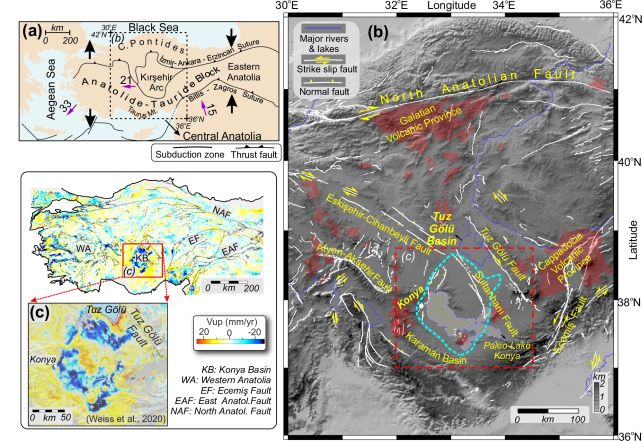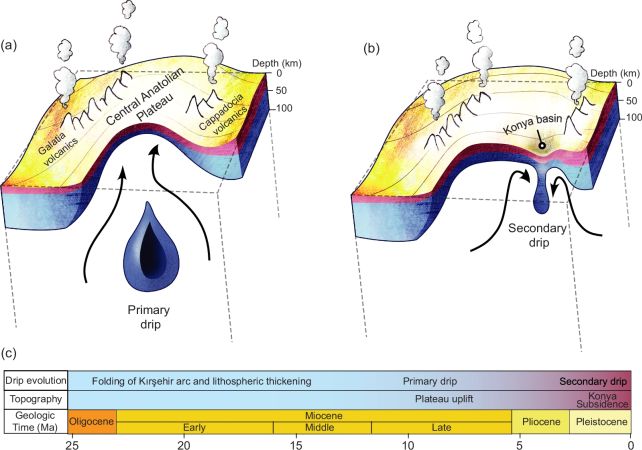Ripples and fissures in the Earth’s surface on the central Anatolian plateau of Türkiye provide the smoking gun for a newly discovered class of plate tectonics.
Under one depression Called the Konya Basin, the Earth’s crust slowly trickles deeper into the planet’s interior, a process that gradually shapes the surface geology of not only the basin but also the plateau surrounding it.
It’s called lithospheric drip, a phenomenon only recently discovered here on Earth, and geologists are still figuring out the different ways it manifests.
“Looking at the satellite data, we observed a circular feature in the Konya Basin, where the crust is subsiding or the basin is deepening,” says geophysicist Julia Andersen of the University of Toronto.
“This prompted us to look at other geophysical data below the surface, where we saw a seismic anomaly in the upper mantle and a thickened crust, which told us that high-density material is present there and points to a likely lithospheric drop in the mantle.”

We have a pretty good idea of how it works. When the lower part of the Earth’s rocky crust is heated to a certain temperature, it begins to become a bit sticky. Then, like honey or syrup, it slowly trickles down—kind of like a pitch-dropping experiment, but much bigger and slower.
As this droplet falls, it pulls the planetary crust down with it. This causes a depression or pelvis. When the droplet is then released into the mantle, the surface rebounds and bulges upward, with a widespread effect.
We have only recently begun to understand this process, but by modeling its evolution, Andersen and her colleagues have already identified one region of the mantle where dripping has occurred, in the Arizaro Basin beneath the central Andes.
Now careful analysis of surface geology and laboratory experiments have led them to a new, moist drop beneath the Central Anatolian Plateau – and the signpost was the Konya Basin.
The Central Anatolian Plateau is known to uplift over time. Previous research shows that the planet has risen in height by about a kilometer over the past ten million years thanks to the release of a crusty droplet.
But then there is the Konya Basin, which is sinking at a rate of about 20 millimeters per year. That doesn’t sound like much, but a sinking piece of land in an emerging region warrants further investigation.
The team’s findings suggest that the wider region of the plateau is in the throes of the rebound phase of the lithospheric drip process, after dropping its sticky molten load into the mantle. The Konya Basin? That is a smaller, second drop formation.
“As the lithosphere thickened and dripped beneath the area, it formed a basin at the surface that later sprang up as the weight beneath it broke off and sank into the deeper depths of the mantle,” says earth scientist Russell Pysklywec of the University of Toronto.
“We now see that the process is not a single tectonic event and that the first drop appears to have spawned subsequent daughter events elsewhere in the region, resulting in the remarkable rapid subsidence of the Konya Basin within the continuously rising Türkiye plateau.”

The researchers validated this model by setting up a laboratory experiment. They filled a Plexiglas tank with a highly viscous silicone polymer called polydimethylsiloxane, as a replacement for the Earth’s sticky lower mantle. A mixture of polydimethylsiloxane and modeling clay was used to replicate the upper mantle, while a mixture of ceramic spheres and quartz sand served as the crust.
They then inserted a dense “seed” into the upper mantle layer to initiate a drop, and observed the results. Within 10 hours the first drop started to fall. By the time it reached the bottom of the box, after about 50 hours, a secondary droplet began to descend.
Neither droplet was accompanied by horizontal deformation of the surface – only vertical. And these deformations were consistent with the Konya Basin.
“What we noticed was that over time, this secondary drip pulled the crust down and started to create a basin, even though there were no horizontal movements in the crust at the surface,” says Andersen. ‘The findings show that these major tectonic events are linked, with one lithospheric drop potentially triggering a host of further activities deep within the planet’s interior.’
These results suggest that lithospheric dripping is a multiphase process, and nicely explain the strange simultaneous uplift and subsidence observed on the Central Anatolian Plateau.
The research was published in Nature communication.



